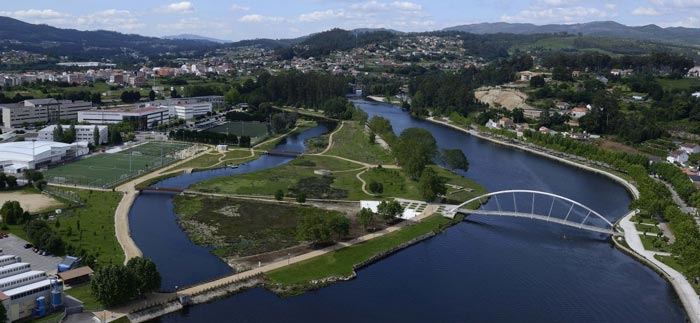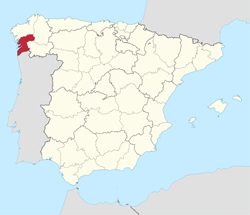Pontevedra in Pontevedra

 The province of Pontevedra is Spain’s 6th smallest with a surface of only 4,495 km2. It is situated in north western Spain, in Galicia, and borders on the other Galician provinces of La Coruña, Lugo and Orense as well as Portugal to the south and the Atlantic Ocean to the west.
The province of Pontevedra is Spain’s 6th smallest with a surface of only 4,495 km2. It is situated in north western Spain, in Galicia, and borders on the other Galician provinces of La Coruña, Lugo and Orense as well as Portugal to the south and the Atlantic Ocean to the west.
It is not a very mountainous province, and its highest point is the Pico Faro at 1,181m A.S.L.. The province is traversed by several big rivers on their way to the Atlantic Ocean, and it boasts the National Park of Atlantic Islands in Galicia, which consists of two islands, Ons in the Pontevedra estuary, Cortegada in the Arosa estuary and the archipelago of Cíes in the Vigo estuary.
Pontevedra is dominated by an oceanic climate with mild temperatures all year round and abundant rainfall. Frost and snow are very rare.
There are 942,665 (2019) inhabitants in Pontevedra province, and the most populated city is Vigo with 295,364 (2018) inhabitants. However, Vigo is not the capital of Pontevedra. This honour falls to the second most populated city, Pontevedra, which is home to 82,802 (2018) people.
It is the only one of Galicia’s cities that grows in population every year, and it is also the one with the youngest population: the average age is 42.9, which is only 1 year above the average for all of Spain.
Pontevedra was founded during the Roman domination of the Peninsula. When the Romans had included Galicia in their Empire, they established trade routes to connect it to the rest of Hispania.
Some of these traversed the river Lérez where a bridge was constructed. A settlement popped up nearby, where the Burgo bridge is today, right in the historic centre.
The city owes its name to that original bridge, which was referred to as the ‘pontem veteram’ in Latin, meaning the oldest bridge over the river. This, over the years, got corrupted via ‘Pontus Veteris’ into Pontevedra.
In the late middle ages, the city started growing due to a number of concessions granted by King Alfonso in 1264, including monopoly on the production of oil from Galician sardines and the allocation of the cargo port for all of Galicia.
The city reached the peak of its prosperity in 1467 when it was granted an annual free trade fair which lasted 30 days. This is still commemorated every year in the first week of September with a Medieval fair named Feira Franca. With the end of the dictatorship in 1975 the construction sector also developed. Improvements in the communications network during the 1980s and 1990s helped Pontevedra to regain weight in the Rias Baixas region, acting again as a trade hub and focusing on its administrative functions as provincial capital. The introduction of university studies in the city during the 1990s contributed further to the growth of the city. Since 1999 Pontevedra has seen intense urban renewal and cultural revival, positively influencing the local economy. In the 21st century the city of Pontevedra has undergone both a cultural renaissance and an urban transformation, taking in the pedestrianisation of the city centre, extension of cycle lanes, recovery of the historical and natural heritage, rehabilitation of buildings and public spaces, and an increase in green areas and pedestrian walkways.
Pontevedra prospered for a couple of centuries until a period of general decline started, which affected all of Galicia, and it was not until well into the 19th century that things started looking up again. This period of decline is known in Galician as Séculos Escuros (dark centuries).
When Spain was divided into provinces in 1833, the city of Pontevedra was made capital of its province on the merits of its previous splendour, and this was the start of the city’s comeback from the dark centuries. It was a cultural melting pot playing an important role in not only in the Galician society, but in all of the Spanish society.
Like the rest of Spain it suffered during the Civil War, but found its feet again and during the sixties and seventies, especially after the democratic transition, a successful and important construction industry emerged which today is one of the primus motors of the Pontevedra economy


